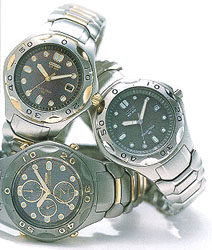The Cartier Tank Rudolph Valentino wore one in his day; Pierce Brosnan wears one now. In between, a gaggle of other movie stars and celebrities - Fred Astaire, Warren Beatty, Elizabeth Taylor, Brigitte Bardot, Marcello Mastroianni, Frank Sinatra, Cary Grant, Jacqueline Kennedy Onassis, Ingrid Bergman, Truman Capote, Henry Fonda, Bob Hope and on and on - have worn a Cartier Tank watch. (Mastroianni bought four in 1961 alone. Capote owned at least eight.) No watch has attracted a bigger coterie of high-profile fans or held onto its status-symbol stature for as long as the Cartier Tank. Rudolph Valentino wore one in his day; Pierce Brosnan wears one now. In between, a gaggle of other movie stars and celebrities - Fred Astaire, Warren Beatty, Elizabeth Taylor, Brigitte Bardot, Marcello Mastroianni, Frank Sinatra, Cary Grant, Jacqueline Kennedy Onassis, Ingrid Bergman, Truman Capote, Henry Fonda, Bob Hope and on and on - have worn a Cartier Tank watch. (Mastroianni bought four in 1961 alone. Capote owned at least eight.) No watch has attracted a bigger coterie of high-profile fans or held onto its status-symbol stature for as long as the Cartier Tank.
It came into being in 1919, when Cartier introduced a rectangular watch with sides similar in shape to the treads of that formidable new weapon, the military tank, which had first been used in combat just three years earlier. It wasn't the first such watch Carther had made - at least one other dates to before the war. What was new was the name, which gave it a clear identity, and a very up-to-date one at that. Within four years, Cartier had brought out four variations on its original design, and many others followed in the subsequent decades (along with an army of Tank imitations from other watch companies). Through all its metamorphoses , into the Tank Chinoise and Tank Allongee (both introduced in 1922), the Tank Basculante (1932), the Tank Francaise (1996) - to name a few - the Tank has proved itself a true classic.
In 1995, Citizen introduced a light-powered watch called Eco-Drive. It turns light - either sunlight or artificial light - into the electricity needed to power the watch. Excess energy is saved in a power cell for future use. No batteries are needed. When fully charged, Eco-Drive watches run for at least 45 days in total darkness. Some can run for an amazing 500 days. (Citizen labels some of its solar-powered watches "Solar-Tech" instead of "Eco-Drive." The names are interchangeable). The Eco-Drive isn't Citizen's first stab at marketing such a watch. In 1976, it brought out the world's first light-powered watch. It wasn't a big seller. Its solar panels were considered unattractive, reminiscent of a calculator. Today's models have no unsightly solar panels. Instead, light enters through the entire watch dial. They're also more efficient in converting light into electricity and can store power for longer periods of time than the old solar watches could. So far the Eco-Drive is a hit. Solar-powered cars may never see the light of day; ditto for solar-heated schools, factories and office buildings. But more solar-powered watches - they're as sure as the sunrise. |
 How do you make a quartz watch, a nearly perfect timekeeper in every respect, even better? Remove its only pain-in-the-neck feature: the battery. Instead, find an energy source you can replenish without lifting a finger, one that's cheap - or better yet, free - and available nearly everywhere. An energy source like light.
How do you make a quartz watch, a nearly perfect timekeeper in every respect, even better? Remove its only pain-in-the-neck feature: the battery. Instead, find an energy source you can replenish without lifting a finger, one that's cheap - or better yet, free - and available nearly everywhere. An energy source like light.
